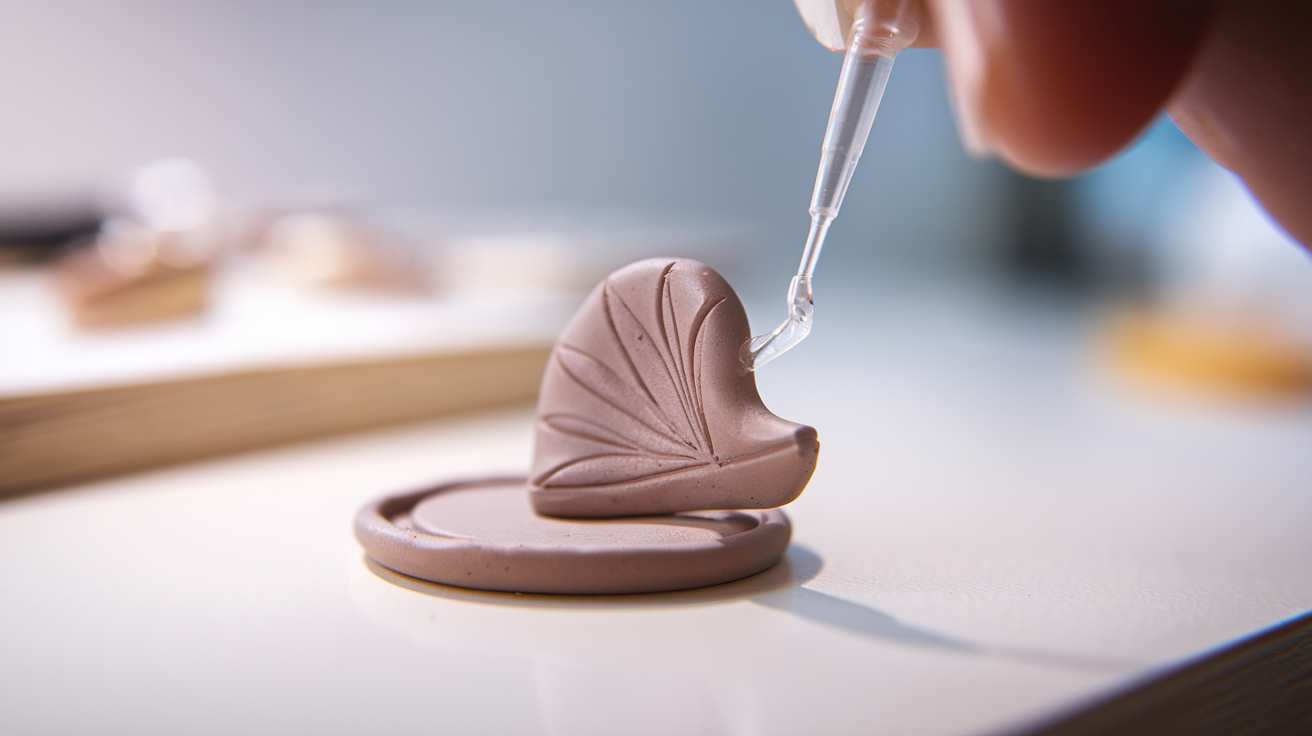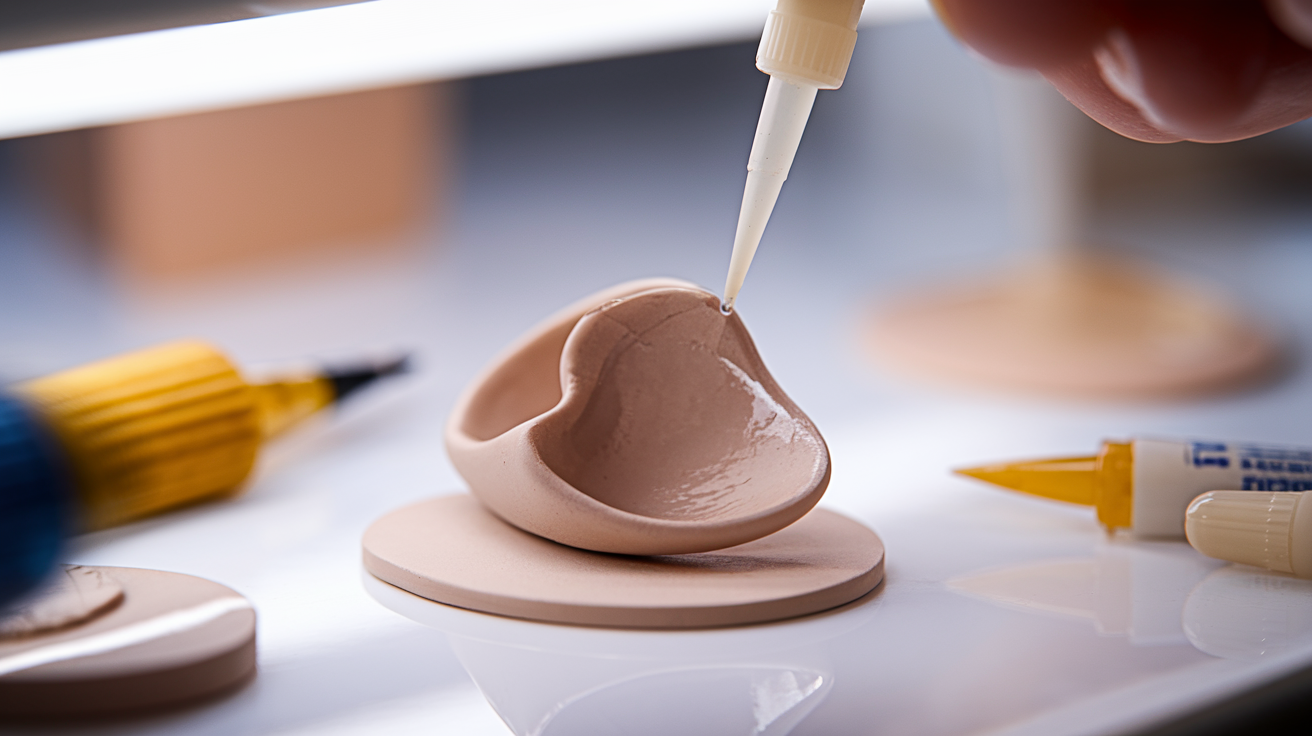Best Glue For Polymer Clay Earrings And How To Use It

Sculpting vibrant polymer clay earrings lets your creativity shine, but reliable attachment of jewelry findings is the secret behind long-lasting, professionallooking results. Polymer clay adhesive choice matters: for the strongest clay-to-metal bond when attaching earring posts or jump rings to cured clay, two-part epoxy and super glue gel (cyanoacrylate) stand out for their durability and messfree application.
E6000 offers flexibility but can create crafting mistakes like bond failures if not fully cured, while liquid polymer clay excels at clay-to-clay bonds when rebaking is possible.
For best results, always sand and clean contact areas with alcohol before gluing and avoid unsuitable adhesives like white or hot glue, which do not provide secure attachment on nonporous surfaces.
Move seamlessly to choosing the right glue formulation for your next masterpiece.
Choosing the Right Polymer Clay Glue
Material compatibility is key; not every polymer clay adhesive forms a reliable bond on nonporous, baked surfaces, so selecting a compatible glue prevents premature attachment failures. Two-part epoxy delivers professional durability and peak performance for earring post glue, especially where sturdiness and longevity are priorities.
Super glue gel excels for quick, clean finishes and is easier to control during application. Liquid polymer clay stands out for embedding findings if you can rebake, while E6000 demands caution due to its odor and occasional brittleness.
For optimal, strong bonds, always test on scrap clay, assess flexibility, and avoid adhesives that are too rigid, as flexibility preserves your durable polymer clay earrings even with everyday wear.
Adhesive Properties and Performance
The properties of your chosen polymer, clay, and glue significantly affect performance and longevity when creating earring components.
Selecting the correct polymer clay adhesive ensures a lasting bond on metal.
Two-part epoxy and super glue gel are top choices for a strong clay-to-metal bond, offering excellent durability and professional results for your earring projects.
E6000 provides a flexible bond but can lead to crafting mistakes if not properly handled; its fumes require good ventilation. Liquid polymer clay is formulated for clay-to-clay bonds, ideal when you can rebake your creations for an integrated attachment.
Surface Preparation Techniques
Proper surface prep is paramount to avoid bond failures and ensure the security of your jewelry findings.
Avoid using adhesives not formulated for nonporous surfaces, as these will lead to immediate attachment issues.
- Lightly sand the attachment spot on the baked clay and the metal post for better grip.
- Clean both surfaces with alcohol to remove any oils or residue that could prevent a strong bond.
- Scoring the area on the clay offers the glue more purchase.
Follow these actionable steps for strong, lasting creations.
Application and Curing Tips
Achieving a seamless, professionallooking finish requires careful application and allowing adequate cure time. Applying too much glue can lead to a mess and potentially weaken the bond.
- Use small dots of glue and align components before pressing to prevent overflow.
- Let the pieces cure undisturbed; disturbing them too soon compromises the bond.
- For added security, optionally cover the base of the post with a thin layer of matching polymer and rebake if your adhesive instructions permit.
- Always follow the adhesive instructions for full curing times to maintain durability.
By adhering to these preparation and application tips, your creations can remain strong and beautiful.

Adhesive Essentials for Polymer Clay Creations
Polymer clay adhesive options extend beyond common glues, as baked polymer‘s nonporous nature necessitates careful glue selection for a truly durable polymer clay earrings bond. Adhesive categories range from rigid types like super glue gel, a fast-setting cyanoacrylate for a firm, immovable hold, to flexible ones like E6000 that accommodate slight movement.
Bakeable choices, such as liquid polymer clay, are ideal for clay-to-clay connections during a rebake process.
Considering how chemicals or pH levels might react with polymer clay is important, as some adhesives may not be fully compatible, potentially leading to bond failures or diminished attachment integrity over time.
For best longevity, store your adhesives in a cool, dry location, sealing caps tightly to prevent premature drying or contamination, ensuring your creations remain secure and professionallooking, paving the way for specific comparisons.
Comparing Popular Polymer Clay Adhesives
Moving from general to specific insights, we explore popular choices for ensuring a strong clay-to-metal bond for your polymer clay earrings.
Super Glue Gel (Cyanoacrylate)
Super glue gel, a type of cyanoacrylate, offers a rapid cure, often within seconds, providing a strong, rigid hold perfect for earring post glue when speed and a messfree application are priorities.
Its fast-acting nature makes it excellent for quick assembly of jewelry findings, though its rigidity might not suit components requiring flexibility. Always use this type of adhesive in well-ventilated areas due to its powerful fumes; ensuring proper surface preparation, like light sanding and cleaning with alcohol to remove any oils or residue, is key to achieving a secure bond.
E6000: Flexibility and Strength
E6000 is a widely used adhesive, offering a good balance of strength and flexibility.
This adhesive cures fully over a longer period, typically 24–72 hours, allowing it to tolerate minor movement, which can be beneficial for durable polymer clay earrings that might experience slight flexing.
While versatile, its effectiveness on polymer clay can sometimes lead to a rubbery or brittle finish over time, and users should be mindful of its strong odor, necessitating good ventilation.
Proper surface prep, including applying to clean, dry surfaces, is essential for optimal performance and longevity.
Two-Part Epoxy: The High-Strength Option
Two-part epoxy is renowned for its exceptional strength and heat resistance, making it a top contender for attaching jewelry findings to baked polymer clay. This adhesive typically involves mixing two components, which then cure to form a very robust bond.
When attaching earring posts, the precision in mixing and application is important to avoid weak spots. Ensure both the clay surface and the metal component are clean and slightly roughened for maximum adhesion.
Proper curing without disturbance is paramount for achieving the strongest possible attachment.
Liquid Polymer Clay: For Clay-to-Clay Bonds
Liquid polymer clay, such as Kato Poly Paste or Sculpey Bake & Bond, proves excellent for clay-to-clay bonds or when embedding jewelry findings can be incorporated into a subsequent baking process.
This method allows for a seamless bond that becomes part of the polymer structure itself.
For best results, ensure the surfaces are clean and ready for rebaking. This technique is particularly useful for reinforcing connections or achieving a professional finish where the adhesive can be baked alongside the clay piece, solidifying the attachment.
Essential Preparation and Application Techniques
Achieving a lasting bond requires attention to detail, from surface preparation to final curing, avoiding common crafting mistakes.
Surface Preparation for Optimal Adhesion
For a strong, reliable bond, proper surface prep is non-negotiable when working with polymer. Begin by ensuring your baked clay pieces are completely cool.
Lightly sanding the area where the attachment will be made on both the clay and the component, such as an earring post, creates a slightly rougher surface for better grip.
Following this, wiping both areas with rubbing alcohol effectively removes any surface oils, dust, or manufacturing residue, preparing the surfaces for optimal adhesion.
For even greater grip, consider light scoring on the clay surface with a sharp tool.
Application Tips for Clean Finishes
When applying your chosen polymer clay adhesive, less is often more; use small dots of glue. This prevents unsightly overflow and ensures a clean finish.
Carefully align your components before gently pressing them together. If any excess glue squeezes out, use a toothpick or cotton swab for precise removal before the adhesive begins to set.
Allow the pieces to cure completely undisturbed, as premature handling can significantly weaken the bond.
Always follow the specific instructions provided with your adhesive for the best security and durability.
Reinforcing and Finishing Touches
For added security, especially with heavier jewelry findings or those under stress, consider reinforcing the base of the attached component.
You can cover the joined area with a thin layer of matching polymer clay. If your adhesive is bakeable, such as liquid polymer clay, you can then rebake the piece to integrate this extra layer seamlessly.
This technique not only adds strength but.
- Polymer clay’s nonporous nature requires careful adhesive selection for durable bonds.
- Adhesives like super glue gel offer fast, rigid holds, while E6000 provides flexibility.
- Liquid polymer clay is ideal for clay-to-clay bonds during a rebake process.
- Proper surface preparation, including cleaning with alcohol and light sanding, is crucial for optimal adhesion.
How to Bond Metal Post
Securing a metal earring post to baked clay requires careful consideration to achieve a strong clay-to-metal bond. For attaching earring posts, two-part epoxy and super glue gels are favored options for their high strength.
Preparation is key to avoiding crafting mistakes that can lead to bond failures.
Begin by lightly sanding the base of both the intended metal attachment point on the polymer and the metal post itself.
Following this, ensure these surfaces are perfectly clean by wiping them with isopropyl alcohol to remove any oils or residue; this step is essential for better polymer clay adhesive grip. For small posts, it’s advisable to apply a precise, small dot of your chosen glue, such as super glue gel or a two-part epoxy, using a fine tool like a toothpick, taking care to prevent any overflow.
Once applied, carefully align the post with its intended position and hold it with gentle pressure or provide support, ensuring it remains undisturbed throughout the entire cure period, which guarantees a secure and professionallooking finish for your creations.
Liquid Polymer Clay for Attachments
As an alternative bonding solution, liquid polymer clay offers a method for creating integrated attachments and contributes to a seamless connection, especially when traditional glue isn’t the most suitable choice. For optimal adhesion, polymer clay’s unique properties must be considered.
Application techniques involve brushing a thin layer of compatible liquid polymer clay, such as Sculpey Bake & Bond, onto both the baked polymer and the designated attachment spot.
The subsequent baking of the fully assembled piece allows the polymer clay adhesive to melt and fuse, effectively securing jewelry findings with minimal mess and an almost invisible joint.
To enhance strength on delicate or thin earring sections, consider reinforcing these critical attachment points with an additional layer of liquid polymer clay before the final bake, and ensure complete full curing for exceptionally durable polymer clay earrings.
| Bonding Method | Key Preparation Steps | Recommended Adhesives | Resulting Finish |
|---|---|---|---|
| Direct Adhesion | Light sanding and cleaning with isopropyl alcohol | Two-part epoxy and super glue gels | Strong, professional-looking bond |
| Liquid Polymer Clay | Brushing a thin layer onto both surfaces | Compatible liquid polymer clay (e. g. , Sculpey Bake & Bond) | Seamless, integrated, and durable connection |
Here’s the refined content:
Avoiding Common Crafting Pitfalls
Polymer clay adhesive selection plays a critical role in preventing crafting mistakes that compromise the security and appearance of your earrings. Proper surface preparation ensures a strong clay-to-metal bond; always begin by cleaning baked polymer clay and metal findings with alcohol to remove oils and residue, then sand attachment points lightly for improved grip.
Glue application should be minimal—applying too much glue or earring post glue increases the risk of mess and weakens the bond, making clean finishes difficult to achieve.
Avoid unsuitable adhesives like tacky glue or white glue, which lack compatibility with nonporous polymer surfaces and often result in bond failures.
Rushing the curing process will disturb the adhesive, so allow full curing undisturbed for maximum durability before handling your creations or moving to the next step. Thoughtful preparation and patience are key for mess-free, professionallooking results and long-lasting attachment.
Achieving Durable Clay Earring Bonds
Polymer clay earring designs that last hinge on both strategic component placement and using a compatible glue such as two-part epoxy or super glue gel.
Weight distribution matters—position connection points and reinforce stress areas, especially on larger pieces, by adding extra earring post glue or scoring the attachment area for better grip. Baked polymer clay can be further protected by covering the base of glued findings with a thin clay layer and rebaking, if appropriate for your adhesive.
Handling finished jewelry with care—avoiding dropping or exposure to sudden impacts—also preserves the integrity and longevity of the bond.
By following actionable tips and proper application techniques, your polymer clay earrings will remain durable and professionallooking, ready for everyday wear.
| Key to Strong Polymer Clay Earring Bonds | Common Pitfalls to Avoid |
|---|---|
| Proper surface preparation (cleaning with alcohol, light sanding) | Using unsuitable adhesives (tacky glue, white glue) |
| Minimal and precise glue application | Rushing the curing process |
| Strategic component placement and weight distribution | Applying too much glue |
| Reinforcing stress areas (scoring, extra glue) | Neglecting careful handling of finished jewelry |
Step-by-Step Mess-Free Glue Application
polymer clay adhesive application requires careful attention to detail and the correct tools for a clean, professional finish. Fine-tip applicators, such as syringe dispensers or small bottles, allow you to dispense earring post glue precisely, helping to avoid overflow and maintaining neat jewelry findings.
Preparing for a Strong Bond
For optimal adhesion, it’s important to prepare your baked clay and the metal earring post meticulously.
Lightly sand both surfaces.
Then, wipe each with rubbing alcohol to remove any residue.
This step ensures a strong clay-to-metal bond. Scoring the surface with a tool can also give adhesives additional grip.
Use small dots of glue.
Align components before pressing together. This prevents overflow and mess, enabling a messfree application.
Applying Adhesives for Durable Earrings
When attaching earring posts, two-part epoxy and super glue gels (cyanoacrylate) are favored for their high strength and reliability.
E6000 is another option, though it can have mixed results.
Liquid polymer clay is excellent for clay-to-clay bonds and for embedding findings if items can be rebaked.
Let your glue cure fully without disturbance. Rushed handling can weaken bonds.
Always use adhesives according to safety recommendations, especially when dealing with strong chemicals or baking. Avoid classic white craft glues, hot glue, or soft adhesives, as these fail quickly on nonporous polymer surfaces.
Not prepping surfaces, like leaving oily residues or dust, results in bond failures.
Applying too much glue can weaken the bond and create a mess.
For a seamless, professional look, cover the glued post with a thin layer of matching polymer clay and rebake if compatible with your adhesive.
This adds security and ensures your durable polymer clay earrings remain professionally looking.
Comparing Top Adhesive Options
polymer clay properties affect adhesive performance and bond longevity. Dedicated products are required for lasting bonds, as polymer clay does not adhere well to all adhesives.
Understanding these differences aids in preventing common crafting mistakes.
Two-Part Epoxy
Two-part epoxy offers a very strong and durable bond. It requires mixing equal parts of resin and hardener.
This type of epoxy creates a rigid bond that is excellent for permanent attachments like earring posts.
Prepare surfaces by lightly sanding and cleaning with alcohol for the best attachment.
Ensure clean finishes.
Lightly sand and clean with alcohol to remove oils or residue.
Super Glue Gel (Cyanoacrylate)
Super glue gel, a type of cyanoacrylate, provides a fast-setting and strong clay-to-metal bond.
Its gel consistency allows for better control, reducing drips and overflow during application. For the best results, ensure the metal post and baked clay surfaces are clean and dry before application.
Apply a small dot of glue.
Press firmly and clean excess immediately with a toothpick or cotton swab.
E6000
E6000 is a versatile industrial adhesive widely used in crafting.
While strong, its performance on polymer can sometimes be unpredictable, potentially remaining rubbery or becoming brittle. It has a strong odor and requires good ventilation during use.
If you choose E6000, allow for full cure time.
Surface scoring can give adhesives more grip. This enhances bond strength for your creations.
Liquid Polymer Clay
Liquid polymer clay is ideal for clay-to-clay bonds and embedding jewelry findings when pieces can be rebaked.
Products like Kato Poly Paste or Sculpey Bake & Bond are formulated.
- Fine-tip applicators like syringe dispensers or small bottles ensure precise application of earring post glue, preventing overflow and maintaining neat jewelry findings.
- Preparing surfaces by lightly sanding and wiping with rubbing alcohol is crucial for optimal adhesion and a strong clay-to-metal bond.
- Two-part epoxy and super glue gels (cyanoacrylate) are recommended for their high strength and reliability when attaching earring posts to polymer clay.
- Classic white craft glues, hot glue, or soft adhesives should be avoided on nonporous polymer surfaces as they tend to fail quickly.




